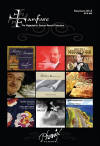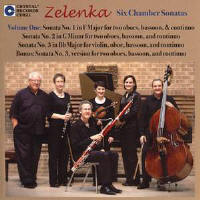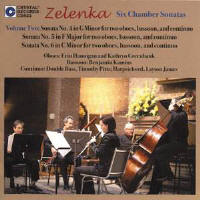Texte paru dans: / Appeared in:
|
|||||||
|
Reviewer: Michael
Carter Despite what many of us think, the revival of interest in the music of Jan Dismas Zelenka (1679–1745) actually is more than a century old. It was none other than Bedřich Smetana who jump-started the movement when he rewrote some scores from the archives in Dresden and introduced one of the composer’s orchestral suites in Prague’s New Town Theater festivals in 1863. As we entered the second half of the 20th century, interest in Zelenka’s music began to grow and by the late 1960s and early 1970s, editions of his instrumental compositions began to appear in what was then Czechoslovakia. The most important effort at that time was the modern premiere of selected Zelenka compositions by Milan Munclinger and his ensemble Ars Rediviva. Since then the music of Zelenka has become widely known through recordings and it has found advocates in such well-known performers as Heinz Holliger and Reinhard Goebel. It was once thought that many of Zelenka’s scores were lost during the fire-bombing of Dresden in February of 1945, but they had been safely stored in the basement of the Japanese Palace. Some of the original manuscripts are indeed missing, but the lost scores represent only a small portion of Zelenka’s work. The total of his authentic and attributed works is 249. They include over 20 Masses, four oratorios, two settings of the Magnificat, and many psalms, hymns, and antiphons. There is also a small number of instrumental works, including the six trio (or quartet) sonatas on these two releases. Zelenka’s instrumental works are noted for their daring and inventive compositional structure, including extensive contrapuntal passages and daring (if not outlandish) harmonic progressions. The music calls on the performers to summon all of their gifts for successful performance, but the music is also fresh and surprising. In particular, Zelenka’s writing for bass instruments far exceeds the demands of other composers of his time. The sonatas date from Zelenka’s years in Prague (the early 1720s) where he had gone to study with Johann Joseph Fux. The manuscript sources are held in the Staatsbibliothek Dresden. Open scores exist for all six works, but parts for only three. Zelenka made corrections by pasting small bits of paper over the original notations but according to annotator and harpsichordist for these recordings, Layton James, sometimes the correction will be in one and not the other, making it necessary for the performers to decide which to use. A note needs to be included here regarding the “Bonus” selection on CD 821. The adaptation of the Sonata No. 3 for two oboes required some tinkering with the violin part as there are passages in which the violinist is required to use the g string, producing notes below the range of the oboe. This is the fourth set of these sonatas that I have received over the years, the others being on Berlin, ECM, and Accent, and it is my third using modern instruments. It is the first however, to appear on an American label and to spotlight an entirely American ensemble. I’m not going to get into the particulars for each of the performers, but I will say that each is well credentialed and is also more than equipped to face the challenges that Zelenka’s music presents. The music springs to life on these two discs, not only because of Zelenka’s unfailing talent, but also because of the abilities of the musicians. The wind players in particular deserve special mention as their understanding and execution of Zelenka’s demanding scores is spot-on and furthermore they are easily the equal of their colleagues on the ECM and Berlin releases. Also the continuo realizations of Layton James are carefully calculated to enhance the overall presentation without drawing attention away from the oboes and bassoon. Tempos are never rushed, but well chosen and as such allow the intricacies of Zelenka’s music to unfold in a natural manner. Intonation is immaculate and ensemble is tight with the colloquy between the winds being exceptionally enviable. Finally, the sound is crystal (pun intended) clear and bright without being hard-edged. These two discs further the already enviable reputation of Crystal, a reputation that took a giant step forward with their complete recording of the wind quintets of Antonin Reicha. Assuming that Crystal continues along these lines, many gems may await us!
| |||||||
|
|
|
||||||
|
|
|
||||||
|
Cliquez l'un ou l'autre
bouton pour découvrir bien d'autres critiques de CD |
|||||||





